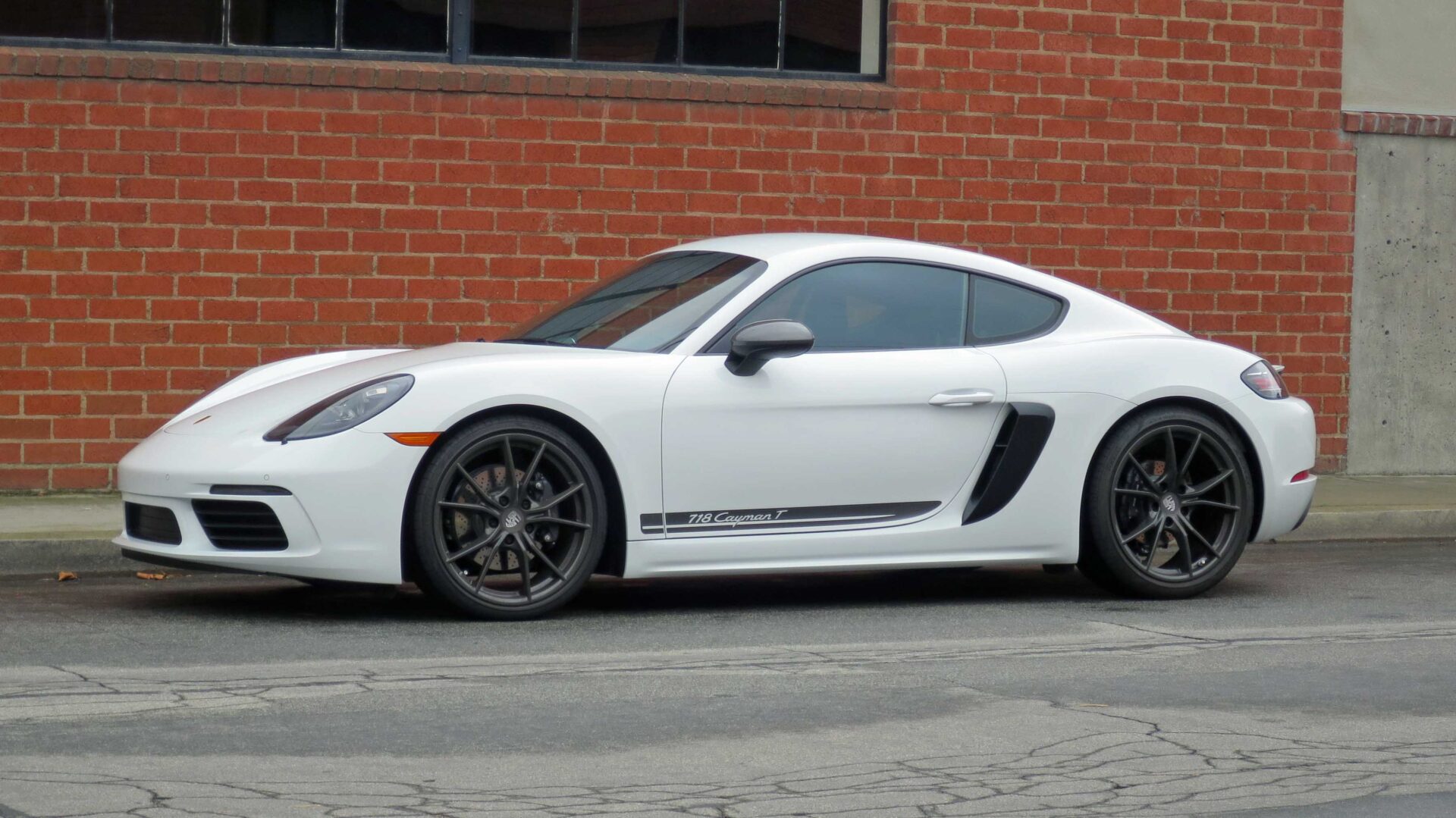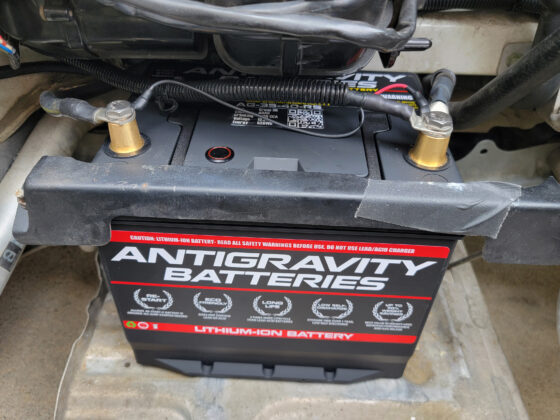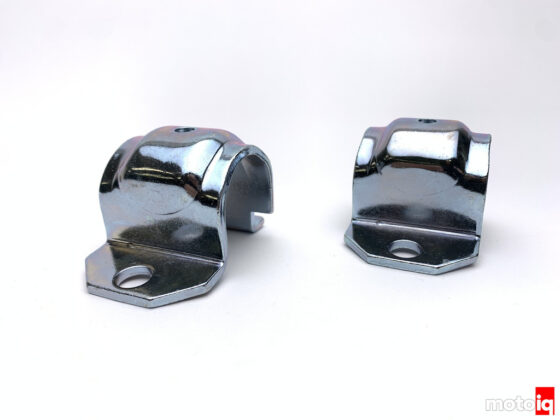 Remember those grills I cut out? I used some wire cutting snips to make some wedges out of their material to jam behind the rear clip features. Now, the rear clips are fully engaged and locked into the side panel so the scoop should not be able to come out. Had I known the grills in the ducts would be so easy to cut, I would not have used the hot plastic knife and the result would have been much cleaner. On the other side panel, the scoops clipped right in, but I still added some wedges behind the clips. These snap retention features depend on dimensions being within fractions of a millimeter accurate. That tightness of tolerance is very hard to do on a large plastic component like the side panel, which explains why the GT4 snapped in properly on one side but not the other. I am going to roll with just the snap features, but one could screw the GT4 scoops to the side panel if one chooses to. That would just require drilling three holes and getting some self-tapping screws for plastic. Screwing in the scoops would be the for-sure retention method.
Remember those grills I cut out? I used some wire cutting snips to make some wedges out of their material to jam behind the rear clip features. Now, the rear clips are fully engaged and locked into the side panel so the scoop should not be able to come out. Had I known the grills in the ducts would be so easy to cut, I would not have used the hot plastic knife and the result would have been much cleaner. On the other side panel, the scoops clipped right in, but I still added some wedges behind the clips. These snap retention features depend on dimensions being within fractions of a millimeter accurate. That tightness of tolerance is very hard to do on a large plastic component like the side panel, which explains why the GT4 snapped in properly on one side but not the other. I am going to roll with just the snap features, but one could screw the GT4 scoops to the side panel if one chooses to. That would just require drilling three holes and getting some self-tapping screws for plastic. Screwing in the scoops would be the for-sure retention method.
 I used two zip ties wrapped around the middle divider to hold the Radiator Grills Store grills to the GT4 scoops.
I used two zip ties wrapped around the middle divider to hold the Radiator Grills Store grills to the GT4 scoops.
 You have to be looking nearly straight into the openings to see the zip ties. At this roughly 45 degree angle, the zip ties are not visible.
You have to be looking nearly straight into the openings to see the zip ties. At this roughly 45 degree angle, the zip ties are not visible.
 The original idea was to do a track day to get some data and then install the GT4 scoops. I got the itch too bad, so I went for just a highway drive at 70mph instead. I was looking at the different sensors I could datalog and the 718 Cayman has an engine compartment temperature sensor. The GT4 scoops are ramming more air into the engine compartment, so I figured the engine compartment temperature would be a good point of reference. The intake air temperature sensor fluctuates quite a lot with throttle position, so it is not a consistent parameter for comparison. The engine compartment was at 54.8degC (the accuracy is not really to the tenth of a degree on this sensor) which was ~32.3degC above ambient.
The original idea was to do a track day to get some data and then install the GT4 scoops. I got the itch too bad, so I went for just a highway drive at 70mph instead. I was looking at the different sensors I could datalog and the 718 Cayman has an engine compartment temperature sensor. The GT4 scoops are ramming more air into the engine compartment, so I figured the engine compartment temperature would be a good point of reference. The intake air temperature sensor fluctuates quite a lot with throttle position, so it is not a consistent parameter for comparison. The engine compartment was at 54.8degC (the accuracy is not really to the tenth of a degree on this sensor) which was ~32.3degC above ambient.
 After I installed the GT4 scoops, I did a repeat of the previous test loop and drive cycle. The engine coolant and oil temperatures and ambient temperature were within a degree of the previous drive. With the GT4 scoops installed, the engine compartment temperature was now only ~27.3 degrees above ambient. This is a reduction of ~5degC and that’s just cruising at 70mph.
After I installed the GT4 scoops, I did a repeat of the previous test loop and drive cycle. The engine coolant and oil temperatures and ambient temperature were within a degree of the previous drive. With the GT4 scoops installed, the engine compartment temperature was now only ~27.3 degrees above ambient. This is a reduction of ~5degC and that’s just cruising at 70mph.
 The GT4 scoops are good at catching little rocks and pebbles kicked up by the front tires. The Radiator Grill Store side intake grills caught their first leaf too.
The GT4 scoops are good at catching little rocks and pebbles kicked up by the front tires. The Radiator Grill Store side intake grills caught their first leaf too.




21 comments
The boostane stuff doesn’t fall out of suspension where others do.
Interesting….. got any links to info? What scared me off of BOOSTane is it’s about 5x more concentrated than the Race-Gas concentrate. The BOOSTane chart says to mix 0.18 oz per gallon to go from 91 to 93 octane.
Fellow T with buckets owner! Excited to see your posts and data. One thing regarding the brakes – while there is ducting from under the bumper to the control arm, the heat shield appears to be solid rather than slotted. Planning on high temp brake fluid/pads, camber plates, lightweight set of track wheels (stock wheels are reasonably lightweight for 20s), and eventually a lightweight battery. The GT4RS underbody aero bits look interesting but probably not streetable.
I was just looking at the GT4RS underbody last night…. It is relatively low cost from Suncoast. I might give them a try and see how they hold up. The main risk I see is them not being too speed bump friendly as they extend a fair amount behind the front tires and I have some big speedbumps in my complex. There was one where if I didn’t take it just right in Project S2000, it would just scratch the catalytic converter. Love the OEM upgrade options though and I plan on implementing more.
If you happen to find yourself at an autox or track day, it would be interesting to see lap times and subjective feel of PTV on/off.
I’m lined up for two track days already. Well, one is the Porsche Driver Experience where I get to drive my own car at PECLA. That road course is actually my favorite in all of SoCal. I plan to spend a good chunk of time on the wet skidpad; I need to develop my car control skills in a drift.
I found a thread a while back where someone who did not get the car optioned with PTV found it hidden in the code and was able to turn it on. They went with a buddy in a BRZ/GT86 out into the canyons with both driving both cars. The owner did observe a noticeable change in turn-in and decided to leave PTV on. I think it would be more beneficial in lower speed, quick transient situations like auto-x or tighter canyon roads as compared to higher speed road course work.
However, I plan to address improving turn-in by getting more negative camber and alignment tweaks. I’m planning to go the GT3 lower control arm route. Eventually, down the road, coil-overs which will have adjustable camber plates too. I am kinda curious what the alignment is now as many have reported their cars coming with the alignment out of whack. But it’s felt okay so far. I’ve gotten up to 1.08G lateral on some on-ramps so far!
The next upgrades will be brakes and cooling. I figure the brakes are going to be the first things to wear out. It’s getting to winter time, so the stock cooling system won’t be stressed, but it’s an easy upgrade with the 3rd radiator install. Wheels/tires/suspension arms when the stock tires wear out. Further down the road, coilovers and DSC module. Man, Porsche parts are expensive…. I definitely need to budget.
Any concern about Dynamic Boost / anti-lag beating up the turbo? No detrimental effects or reduced life? I know it’s not rally anti-lag or “let’s make lots of noise under the Braker Lane U-turn” but does it hurt the spinny bits?
There is an EGT sensor I can datalog. I’ll have to do that. That said, I expect Porsche keeps the EGTs below limits which is the purpose of having the EGT sensor. Heck, the Dynamic Boost might even help with fatigue life by reducing amplitude of the thermal cycling. Definitely not good for gas mileage though.
I watched Fenske’s explanation of Dynamic Boost- seems like it shouldn’t hurt the turbo. What would be a good EGT limit to not exceed for good turbine life?
If it’s just open throttle on decel with a little fuel, I wonder if I can emulate that on another engine? Is it switchable on/off without plugging in a computer- to switch between playtime anti-lag and daily driven economy?
Run of the mill gas turbo systems typically have a limit of 980C EGT. Performance gas turbo setups with higher grades of stainless steel manifolds and turbine housings and MarM turbine wheels can handle 1050C.
Just need electronic throttle and electronically controlled BOV. We talked about it at Garrett like a dozen years ago. So Porsche implemented something roughly half a decade after out teams thought of it.
Just have to turn the Sport Chrono knob on the wheel from Normal mode to Sport + to turn on /off Dynamic Boost.
70C doesn’t seem like that much of a jump in heat tolerance!
I’ve got the electronic flappy throttle covered and can’t imagine an electric BOV would be difficult to program in and control. Now I just need your nifty spinny button to add to the steering wheel…
70C is huge.
70C is enough to drive a change in specification of materials. On the turbo at least, turbine housing material changes from 1.4848 to 1.4849 stainless steel and the turbine wheel from Inco to MarM. On the engine side, higher spec valves have to be used. I remember during early Ecoboost 2.3L Mustang engine development, Ford initially asked for the 1050C EGT limit so they could get the better performance. Then when they found out how much more expensive parts would cost, they settled on the 980C temp limit. But the Focus RS got the upgraded materials and the higher power rating. I think 350hp vs 315hp if my memory still works. Someone can look it up.
I bought a quickjack because I was sick of jack stands. My Golf R has the same issue where the jack points are the jack stand points. The quickjack was spendy, but I have zero regrets. It just makes lifting the car so much easier.
I ordered some lift bars. 6-8 week lead time. Hope to have them before the next oil change!
I found some Porsche literature on Dynamic Boost:
Dynamic Boost function: The responsiveness of a naturally aspirated engine
When it came to tuning the exhaust gas turbocharger, Porsche engineers placed
particular importance on ensuring that the responsiveness of the turbocharged 718
engines was comparable to that of a naturally aspirated engine. This is achieved in
several ways, including pre-spooling of the turbocharger at partial load. With Sport and
Sport Plus modes activated, the bypass valve is closed, the ignition angle is retracted
and the throttle is slightly opened. While the current drive torque is unchanged, air flow
through the engine increases, elevating boost pressure. If the driver demands
maximum acceleration, the higher boost pressure results in increased torque.
The Dynamic Boost function is activated when the driver briefly takes their foot off the
accelerator while accelerating at full speed: despite change in load, the throttle remains
largely open, and only the fuel injection stops. When this happens, the boost pressure
does not drop completely and the engine responds quickly when the driver accelerates
again, creating a level of responsiveness normally associated with a naturally aspirated
engine. This Dynamic Boost function also improves responsiveness in Normal mode,
albeit to a slightly lesser extent.
The turbocharger reacts similarly when the driver presses the Sport Response button,
which is located in the center of the drive mode selector on the steering wheel. It primes
the engine and transmission to respond more spontaneously for up to 20 seconds.
When the driver presses the Sport Response button the PDK also downshifts and shifts
more quickly than Sport Plus mode.
Khiem or Mike K.,
Can you comment at the front tire air strakes that are in front of the tire, the GT4 has something similar but it is removable with two screws. The GT3/GT2 has noting there at all. For the purpose of reducing lift, would it back sense to trim these front tire air strakes short or off completely?
Good question! On the T, those strakes are certainly for drag reduction. I suppose removing them would reduce lift a bit (they should be creating a high pressure spot on the bottom of the car) at the expense of drag. On the GT4, it has the removable spoilers placed in the integrated diffuser channels in the front under tray. Definitely drag vs lift trade-off as noted in the Porsche manual for track setup of the GT4. As for the lack of front tire strakes on the GT3/GT2, my guess is they would disrupt the airflow into the front under tray diffusers too. And those cars are so low stock, maybe they are also just completely impractical. Unlike GM philosophy on the C5 Vette and old Volt that had those super low air dams that scrapped and got bent on everything.
Thanks Khiem,
I am asking as I also have a 718 Cayman and looking to improve aero, reduce drag, without the use of a huge wing or aggressive front splitter. I can see the value of these making a bit of high pressure as right next to them is the ducting for the front brake cooling.
Can you comment on the point of the RS Strakes that they add after the front wheels to presumably get the air from the front wheel well out of the side of the car instead of leaving it underneath the car for the diffuser to deal with? What might also be of concern when discussing the rear of the front tire strakes is cars with a third radiator might be dumping that air back underneath the car unless you are using the GT4 front bumper which routes the vent up and overt he hood. The GT4 has a simple version of the behind the front tire effects with just one spat or strake.
Here is an example of the RS strakes, note that it is also available in a 4 piece kit without the center pieces, those are available separately as well.
https://www.suncoastparts.com/product/pkrsscoops.html
There are a few people who have done the full GT4 front bumper conversion and GT4 center radiator which is different than for the lower Caymans. GT4 center radiator is wider and angled forward to vent air out the upper bumper vent. Our lower Caymans have a smaller radiator angled downward to vent underneath. I had some thoughts of making the GT4 center radiator work with the base bumper which really just needs a custom middle plastic duct made. Certainly possible with 3d scanning and print like Kojima’s STI oil cooler duct. But… That’s more effort than I want to put in on that particular aspect of the car. My plan is 3rd radiator but add the rennline Gt3 smile vent so the air will duct out both above and below.
As for the GT4 starkes, look up my McLaren 720 article. A reader had really good info on the purpose of the stakes. Long story short, they push the turbulent air caused by the tires out the sides of the car so there is cleaner airflow to the diffuser to improve diffuser performance. The strakes will create a little front end lift. As a mild cleanup of underbody aero, you could add the GT4 under tray before the diffuser panel. If I end up adding the GT4RS strakes, my thought is for trying to improve cooling performance by getting more air through the side ducts which have to dump out the bottom rear of the car. I figure less dirty air going in under the car to the rear should make it easier for air going thru the ducts to dump out and therefore get more flow. And maybe even help get more air thru the third radiator.
Thanks Khiem,
You have left me some things to think about.